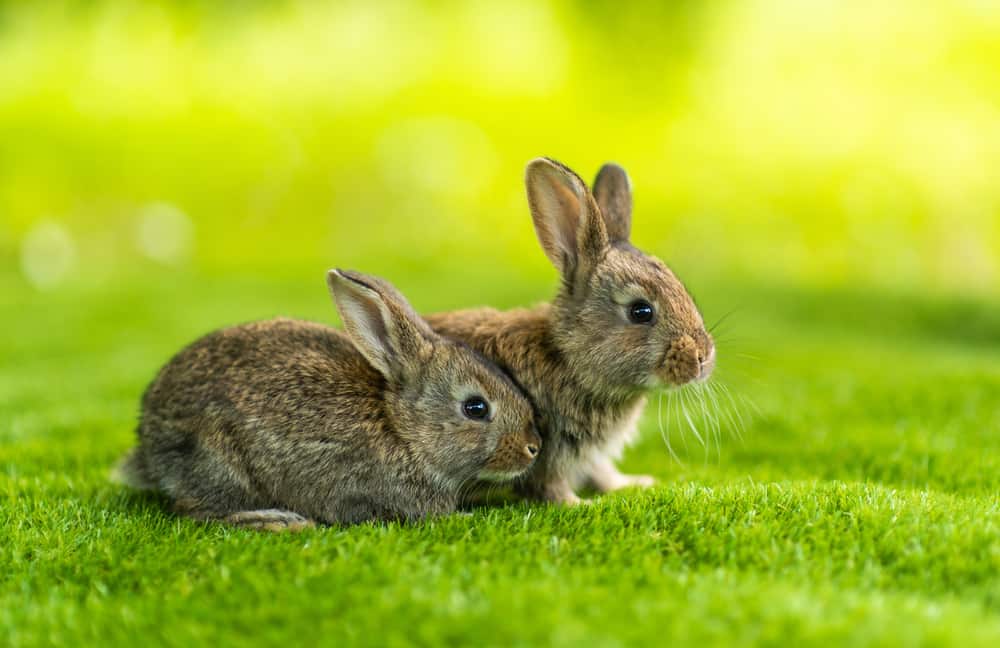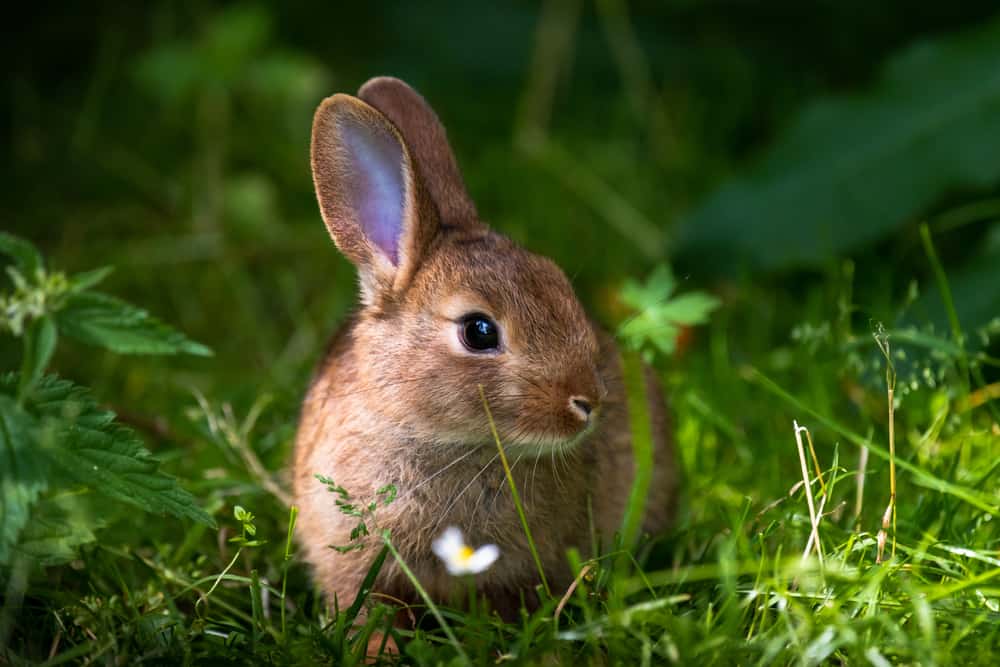The Leporidae family is a group of mammals that includes hares and rabbits. These animals are found throughout the world, with species adapted to various environments from deserts to forests. The Leporidae family is known for its unique physical characteristics such as long ears, powerful hind legs, and short tails.
The taxonomy of the Leporidae family has been subject to much debate over the years due to their diverse morphological traits and geographical distribution. However, most researchers agree that there are around 60 different species within this family.
Despite differences in size and appearance, all members of the Leporidae family share similar biological features related to reproduction and feeding habits.
This article aims to provide an overview of the key aspects of these fascinating creatures, including their evolutionary history, behavior, ecological roles and conservation challenges.

Genera
- Genus Brachylagus – pygmy rabbit
- Genus Bunolagus – riverine rabbit
- Genus Caprolagus – hispid hare
- Genus Lepus – hare
- Genus Nesolagus – striped rabbit
- Genus Oryctolagus – European rabbit
- Genus Pentalagus – Amami rabbit
- Genus Poelagus – Bunyoro rabbit
- Genus Pronolagus – red rock hare
- Genus Romerolagus – volcano rabbit
- Genus Sylvilagus – cottontail rabbit
Origins And Evolution Of The Leporidae Family
The Leporidae family, commonly known as rabbits and hares, is a diverse group of mammals that belongs to the order Lagomorpha. The origins and evolution of this family can be traced back to the early Oligocene period approximately 33.9 million years ago.
The phylogenetic relationships within Leporidae have been extensively studied using molecular data, morphological characteristics, and comparative anatomy. The comparative anatomical studies reveal that the primary distinguishing features between rabbits and hares are their size, ear length, leg length, skull shape, dental formulae, and pelage coloration.
Rabbits tend to be smaller in size with shorter legs compared to hares which are generally larger in size with longer ears and legs. Furthermore, rabbits usually have a more rounded skull while hares possess a flatter skull structure. These differences in morphology reflect adaptations for different ecological niches such as burrowing for rabbits or swift running for hares.
Unique Physical Characteristics Of Hares And Rabbits
As discussed in the previous section, the Leporidae family has a long and diverse evolutionary history. Despite their differences in appearance, hares and rabbits are members of this family and share several unique characteristics that distinguish them from other mammals.
In this section, we will explore some of these physical traits that make hares and rabbits so distinctive. Behavioral adaptations are an essential aspect of hare and rabbit survival, as they have evolved to thrive in specific habitats. One common adaptation is their ability to reproduce quickly, allowing them to maintain healthy populations despite high predation rates.
Furthermore, many species exhibit nocturnal behavior or burrow underground during the day for protection against predators. Hares also possess sharp claws on their hind feet that allow them to run at incredible speeds over rough terrain while avoiding danger. While both groups prefer open areas with plenty of vegetation, rabbits tend to stay closer to cover than hares do, utilizing brushy thickets or woodlands when available.
These behavioral adaptations ensure that hares and rabbits can successfully inhabit various environments worldwide.
Cottontail Rabbits’ Predators Exposed: Unraveling the Threats
Reproduction And Life Cycle Of Leporidae
Imagine a race that is inextricably tied to the cycles of nature, one whose life cycle aligns with the changing seasons.
This is the story of Leporidae reproduction and life cycle, which are closely linked to environmental factors such as temperature, food availability, and daylight hours.
Female Leporidae reach sexual maturity between 3-8 months, depending on the species. They have an induced ovulatory response where copulation triggers ovulation resulting in fertilization of eggs within minutes or hours.
The gestation period for most leporids ranges from 28-35 days after which females give birth to litters ranging from 1 to 14 young ones called leverets.
Leverets are born blind, naked and completely helpless, but they grow rapidly due to their mother’s milk which contains high fat content crucial for growth and development.
Feeding Habits And Ecological Roles
Leporids are herbivorous animals that feed on a variety of plant materials, including grasses, herbs, bark, twigs, buds, and leaves. Their foraging behavior is mainly influenced by the availability of food resources in their habitat.
They are known to be selective grazers during winter months when food sources are scarce or limited. During summer seasons with abundant vegetation cover, they tend to consume more fibrous plants which contain high levels of energy.
Predator-prey dynamics play an important role in shaping the feeding habits and ecological roles of leporids. Leporids have been observed using different anti-predator strategies such as camouflage and hiding among dense vegetation covers while foraging to avoid detection by predators.
However, despite these adaptations, they remain preyed upon by various carnivores such as foxes, coyotes, eagles, hawks among others. In turn, leporids serve as a critical source of food for many predators and contribute significantly to the overall balance of predator-prey relationships in most ecosystems where they occur.
Threats To Leporidae And Conservation Efforts
Human impact has been a significant threat to Leporidae population across the world. The most pressing issue is habitat loss due to human activities like agriculture, urbanization, and deforestation. These actions have resulted in fragmentation of their natural habitats leading to reduced movement patterns, genetic diversity, and increased susceptibility to diseases. Additionally, these factors have also led to the decline in food resources for Leporidae species.
Conservation efforts are underway globally with focus on conservation breeding programs aimed at conserving threatened species by preserving them in captivity and reintroducing them into their natural habitats.
Habitat restoration projects that aim at restoring degraded ecosystems back into functional habitats for Leporidaes have also been initiated worldwide. Moreover, awareness campaigns aimed at educating local communities about conservation measures for this vulnerable group of animals continue being implemented as well as policies geared towards halting further destruction of leporidae’s natural habitats through sustainable land use practices.
In conclusion, it is essential that more emphasis be placed on conserving Leporidae populations since they play a crucial role in maintaining healthy ecosystems and balancing biodiversity levels within such environments.
Leporidae In Popular Culture And Folklore
Despite the threats facing Leporidae, these creatures have held a significant place in human culture and mythology for centuries. In literature, rabbits and hares have been featured in works ranging from children’s stories to epic poems. They often serve as symbols of fertility, speed, or cunning intelligence.
In folklore, mythical hares are prevalent in many cultures around the world. The Chinese legend of the Jade Rabbit tells of a selfless hare who sacrifices himself to feed a hungry traveler. Meanwhile, European tales feature the Easter Bunny who brings eggs and candy to young children on Easter Sunday. These stories reflect our enduring fascination with these animals and their symbolic significance in our lives.
Despite being hunted and threatened by habitat loss, Leporidae continue to captivate us through popular culture and storytelling.
Leporidae in literature serves not only as an important element but also helps understand how humans perceive these small mammals throughout history. From Beatrix Potter’s Peter Rabbit to Lewis Carroll’s White Rabbit in Alice’s Adventures in Wonderland, rabbits have played various roles that represent certain qualities like wit or vulnerability. Furthermore, they offer readers moral lessons about responsibility or the consequences of one’s actions.
While some writers utilize leporidae characters purely for entertainment purposes, others use them as metaphors for social issues such as classism or imperialism.
Mythical hares create another layer to this cultural significance associated with Leporidae; however they do so without any scientific basis rather solely rely on ancient beliefs passed down orally over generations. Notably, many cultures incorporate lunar myths involving rabbits believed to reside on the moon itself- a concept also recognized by NASA which named its Lunar Orbiter spacecraft series after “Ranger” preceded by names of several animals including “hare”.
As we continue to explore new ways of understanding nature and incorporating it into our daily life, leporidae remain a symbol of mystery and wonder that hold immense value to humanity.

Conclusion
The Leporidae family is a fascinating group of animals with a rich evolutionary history.
Hares and rabbits, the two main groups within this family, share several physical characteristics that set them apart from other mammals.
Their unique reproductive cycle also plays an important role in their survival.
As herbivores, they play crucial ecological roles by controlling vegetation growth and serving as prey for many predators.
However, human activities such as habitat destruction and hunting have led to population declines in some species.
Conservation efforts are underway to protect these iconic creatures, but it will take concerted effort from individuals, organizations and governments alike to ensure their continued existence.
Despite the threats facing them today, hares and rabbits continue to capture our imaginations through popular culture and folklore – reminding us of our interconnectedness with the natural world.
As stewards of this planet, we must do all we can to preserve these beloved members of the animal kingdom for future generations to appreciate and enjoy.

